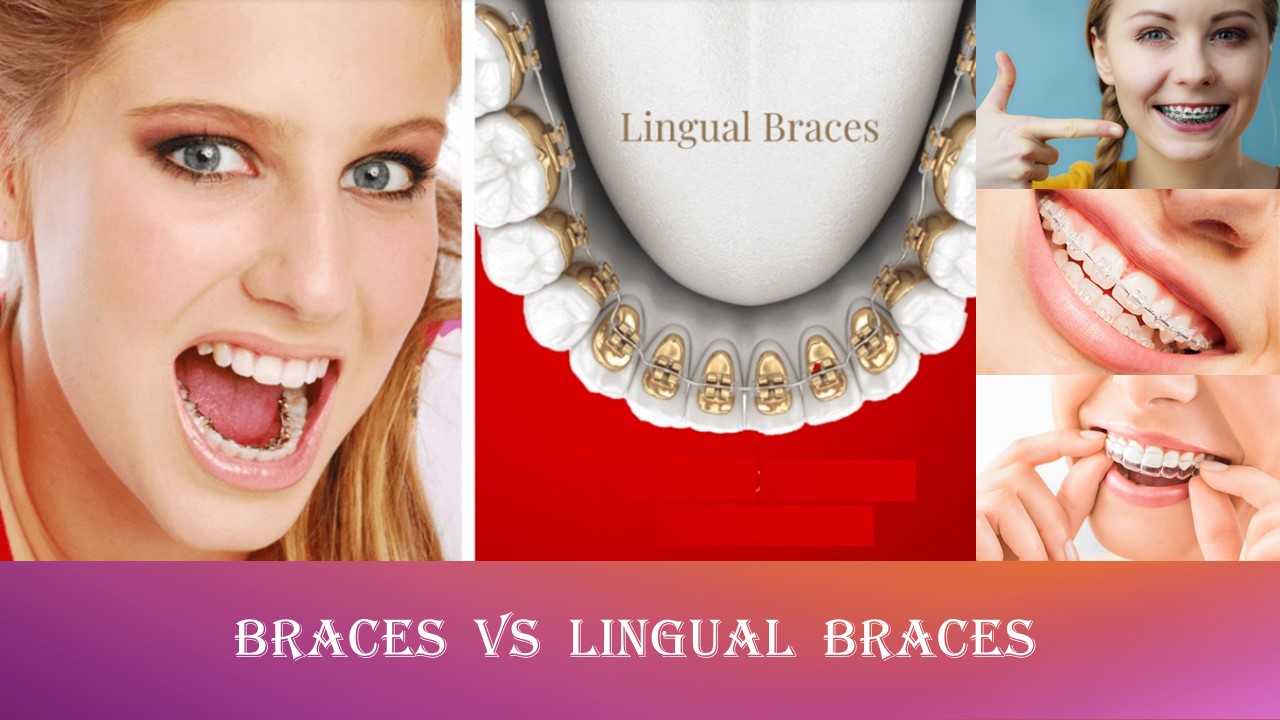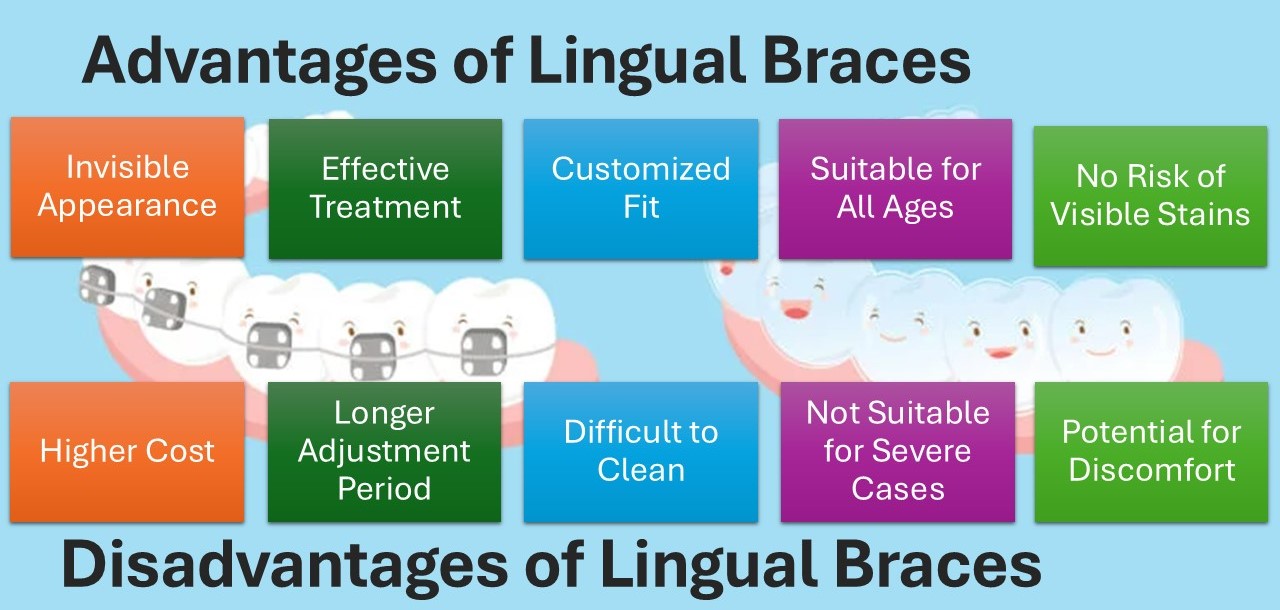
Braces are orthodontic treatments that enhance the appearance of the jaw and teeth, improve the chewing ability, and promote oral hygiene by aligning the teeth properly. In these treatments, aesthetic considerations typically determine the preferred method. It's these aesthetic considerations that make lingual braces preferable. In this technique, the visibility of the concealed braces behind your teeth is minimal, unless you explicitly inform someone about them.
Having said that, lingual braces are not something every orthodontist is qualified to do. With this approach, which involves the placement of brackets and wires on the lingual side of the teeth, the application of force from a different angle necessitates more intricate calculations to achieve the desired tooth movement compared to conventional methods.
Now, let us delve into this less familiar method and explore others in greater depth, analysing the distinctions between them.
Braces
Typically, there are three types of braces treatment available: metal, porcelain, and Invisalign. In addition to their noticeable appearance, these treatments vary in duration, comfort level during application, and range of tooth motion they provide.
Metal braces
Although metal braces may not be as aesthetically pleasing as porcelain and Invisalign alternatives, they are nonetheless highly effective for cases requiring simultaneous adjustment of all teeth. This is because metal braces have the ability to exert force in a more consistent manner due to their structural composition. As a result, the movement of the teeth becomes more predictable.
Ceramic braces
Porcelain braces offer superior aesthetic results compared to metal braces; however, the treatment time may be slightly longer due to the lower force that porcelain braces can produce. Additionally, hard bites can easily break porcelain wires or brackets. Porcelain braces are also more prone to breakage and chipping than metal ones, which means they might not exert uniform pressure and may require more frequent adjustments.
Invisalign clear aligner
Invisalign aligners, without sacrificing effectiveness, offer a practically perfect aesthetic solution. Specifically, when addressing dental issues involving individual teeth or localised areas, clear aligners provide superior functionality and the potential for expedited outcomes compared to traditional metal braces. Nevertheless, in cases where all teeth need to be opened or closed simultaneously, Invisalign treatments are inferior to their porcelain or metal counterparts. Furthermore, since Invisalign aligners can exert more force on certain teeth, they need to be checked and adjusted more frequently than other types of aligners.
Lingual braces

In lingual orthodontics, the patient has metal brackets and wires affixed to the back of their teeth. When it comes to aesthetics, lingual braces treatment is unrivalled. Their existence is practically invisible. Unless you specifically point them out, no one will be able to tell that you are wearing braces.
How does a lingual function?
The lingual braces are smaller in size and require a more meticulous production process because of the positioning of brackets on the back surface of the teeth. In addition, the limited space on the back surface of the teeth may require the dentist to make complex calculations in order to apply the desired force in the desired direction. Because of this, not all orthodontists are qualified to treat patients with lingual braces.
Advantages
Some important advantages of lingual braces are as follows:
Invisibility
Lingual braces are significantly more costly than other types of braces. While the material utilised in this treatment is identical to that of metal braces, the requirement for an orthodontist with specialised training and the treatment process substantially elevate the cost of the treatment.
Adaptation challenges
It is common to experience some discomfort for three to four days after any braces treatment and for one to two days after the renewal of braces. Lingiual braces are no exception in this regard. However, in lingual treatments, irritation of the tongue due to the contact of the wires with the tongue and temporary pronunciation disorders may occur.
Cleaning and maintenance difficulties
One of the most important disadvantages of lingual braces is undoubtedly that they are more difficult to clean. Fortunately, this issue is easily remedied by devoting a bit more time to dental cleaning.
Comparison of orthodontic braces
Now that we know what braces are, let us see how these four treatments stack up against one another and see which one works best in which situations.
Aesthetics
Aesthetically, lingual braces have undeniable superiority. Because of their translucent and white colour, porcelain braces can also be said to produce satisfactory results. The aesthetic outcomes of Invisalign braces, on the other hand, are exceptionally good because they are undetectable from a distance of 2 meters and beyond.
Cost
The aesthetic advantages of braces are directly proportional to their price. Based on cost, the most economical treatment options are metal braces, ceramic braces, invisalign, and lingual braces, in that order. The table below shows the average prices for braces in the UK and the USA.
|
Type of Braces |
Average Cost (No Insurance) - US |
Average Cost (With Insurance) - US |
Average Cost (No Insurance) - UK |
Average Cost (With Insurance) - UK |
|
Traditional Metal Braces |
$3,000 to $7,500 |
$1,750 to $4,000 |
£2,500 to £6,500 |
£1,500 to £3,500 |
|
Ceramic Braces |
$3,000 to $8,000 |
$2,000 to $4,500 |
£2,500 to £7,000 |
£1,700 to £4,000 |
|
Lingual Braces |
$5,000 to $12,500 |
$3,500 to $9,000 |
£4,000 to £10,000 |
£2,500 to £7,500 |
|
Clear Plastic Aligners |
$3,000 to $7,000 |
$1,500 to $3,500 |
£2,000 to £6,000 |
£1,200 to £3,000 |
|
Direct-to-Consumer Clear Aligners |
$1,700 to $5,500 |
£1,200 to £4,000 |
Comfort
During the initial stages of any braces treatment, patients may experience some pain, which typically diminishes over time. While everyone has a different threshold for pain, the force that braces apply plays a significant role in how uncomfortable a person feels. So, metal and lingual braces can induce greater discomfort compared to ceramic braces. In Invisalign braces, the application of force to specific areas may result in heightened discomfort in those regions. However, this discomfort tends to subside more rapidly compared to metal braces. Invisalign users may also find the pain more tolerable due to the ability to remove the aligners.
Effectiveness
Invisalign aligners are the most effective option for correcting a single tooth. On the other hand, lingual braces and metal braces may work better to straighten all of the teeth simultaneously.
Cleaning and care
Invisalign aligners offer optimal convenience for maintaining oral hygiene during orthodontic treatment, as they can be easily removed for a total of two hours per day. On the other hand, lingual braces pose the greatest challenge when it comes to cleaning. Removing food particles from the brackets positioned behind the teeth may require some diligent attention.
FAQ
Below, you'll find a selection of the most frequently asked questions and answers that highlight the key differences between lingual braces and other types of braces.
What is the main difference between lingual braces and invisalign?
Both the Invisalign and Lingual braces are practically invisible. Even though Invisalign aligners are barely visible from a distance of one to two metres, they still manage to look incredibly sophisticated. However, lingual braces are hidden behind the teeth, making them nearly undetectable from any distance.
Will lingual braces affect my speech?
Lingual braces may result in transient speech difficulties in certain patients, although not all individuals are affected. These adverse effects cease once the patient becomes accustomed to the treatment.
Which treatment provides faster results: lingual braces or invisalign?
For minor crowding or a single tooth, Invisalign braces can straighten your teeth much more quickly than traditional metal braces. However, in cases where all of the teeth need to move at the same time, lingual braces give faster results.
Do lingual braces damage teeth?
In lingual orthodontics, the braces are fastened to the teeth using adhesives that can be easily removed by the dentist after treatment—all without harming the tooth enamel.
Which is more convenient when eating?
Placing the brackets behind the teeth in lingual braces makes them less vulnerable to hard bites, which makes eating with them easier. Having said that, lingual braces have been known to break in patients with overbite due to the pressure from the back teeth. Therefore, the bite turbo is used on the posterior teeth of individuals with an overbite issue to prevent the braces from coming into contact with improper occlusions.
Which brace treatment is more comfortable?
While invisalign braces may cause similar levels of discomfort as other types of braces, they provide a more comfortable treatment experience due to their ability to be removed for two hours each day and their ease of cleaning.
Conclusion
Aesthetic concerns often deter patients from pursuing orthodontic treatment. Lingual braces offer a discreet solution that completely alleviates these worries, as they remain entirely hidden from view. At Antlara Dental, our experienced orthodontists, with over 30 years of expertise, are dedicated to providing you with exceptional care throughout your orthodontic journey. Trust our skilled professionals to guide you every step of the way, ensuring a seamless and confident treatment experience.
